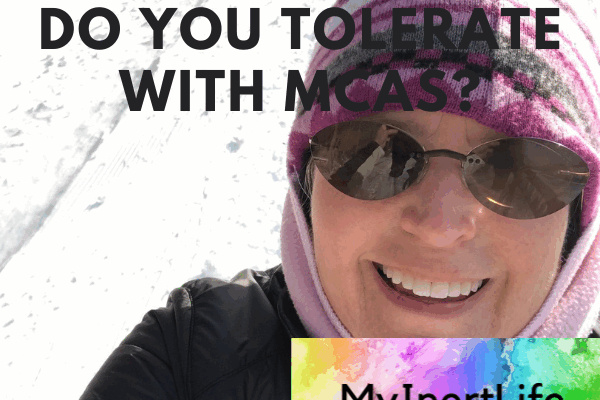This post is Day 7 Backpacking the SHT continues my journey on the Superior Hiking Trail with a chronic condition called Mast Cell Activation Syndrome (MCAS).
Table of Contents
What is MCAS?
Mast Cell Activation Syndrome (MCAS) is a chronic condition that affects all organ systems. MCAS is serious and disabling and people with MCAS experience often significant and debilitating symptoms daily, including anaphylaxis, which can be fatal.
MCAS is often found in combination with other chronic conditions such as Ehlers-Danlos Syndrome (EDS) and Postural Orthostatic Tachycardia Syndrome (POTS).
Frequently healthcare providers do not know about MCAS, and the tests for MCAS are problematic because they are not uniformly reliable. MCAS can be difficult to manage. Treatments include blocking mast cell mediators with anti-histamines and mast cell stabilizers, as well as avoiding triggers.
Check out this post on how to manage MCAS.
Up to Pincushion Overlook
In the morning I packed up my gear, had breakfast, and started along the trail I had encouraged the lost couple to take last night. It was clear and somewhat breezy so the bugs weren’t too bad. Soon I came to a flight of over 200 steps up to the ridge above the Devil Track River. I realized the couple must have been reluctant to go that way because they knew they would have to ascend those steps! I continued to pray for them as I started upward.
At the top of the ridge, many crisscrossing Pincushion trails made it very confusing to stay on course, and I saw the junction where the couple had easily gone astray. I carefully followed the blue blazes on the trees marking the SHT. Several times I had to check Gaia GPS to ensure I was still on the right path while in the Pincushion trail system.
I took the short spur to the Pincushion Overlook, and came to a magnificent panoramic view of the area! I snapped a few pictures, took advantage of the cell service to text my family, and then headed back to the main trail.
Merino wool rebirth!
The breeze was brisk up at the overlook and my sweaty clothing quickly dried out. I’ve been wearing merino wool clothes for this trip, and I’ve been so grateful for the warmth and quick-drying lightweight fabric. I have not been able to wear wool of any kind since childhood due to my MCAS, so this has been a big change for me. I mean, usually, I would need to take Benadryl after accidentally brushing against wool!
But as I was combing through the racks at Sierra a few weeks ago I was guided to try on a Merino Icebreaker top that was discounted 75% off, and surprisingly I didn’t react to the wool. Then I found some Icebreaker Merino running shorts on sale and a set of Merino wool long johns to use as my sleep clothing.
It’s been miraculous being able to wear Merino wool and not have negative symptom reactions, and I credit the change to the nervous system retraining work I’ve been doing over the last year called the Safe and Sound Protocol (SSP). The SSP relies on a simple app where you listen to recorded classical music that has been specifically filtered to positively affect the nervous system.
Healing PTSD
The reason I have been doing SSP stems from the years of caregiving I’ve done, and the PTSD I accrued due to multiple small and large traumas. A combination of PTSD, toxic mold exposure, and a series of concussions starting in childhood are what led to my big MCAS flare several years ago, and I’ve found that SSP has been one of the biggest game-changers on my healing path. As my nervous system has healed I’ve been able to take more risks with the foods I eat, experiment with doing more physical exertion like the Korteloppet ski I did last spring, and now this trip.
In addition to being able to wear wool clothing and eat a wider variety of foods, I have experienced dozens of small healing moments like this throughout the last year, making me realize that my nervous system was holding me back from experiencing life fully and joyfully. I am so grateful for SSP!!!
On this trip, I’ve also noticed that being out in nature has been regulating for my nervous system in and of itself. In the last three days, I’ve been without many of my common daily symptoms like temperature dysregulation, neuropathy, and joint pain that I usually experience at home, though I did experience tinnitus.
Excited for more!
Anyway, back to my story! I continued to follow the blue blazes marking the SHT as I hiked the remaining 1.5 miles to the parking lot. I saw a handful of folks doing day hikes, bringing the final tally for this trip to fourteen women, six men, and three dogs.
I celebrated this accomplishment by buying a shower at the campground (heavenly!) and treating myself to some picnic foods from the co-op and eating them by the lake.
That’s it for this section of the SHT! I’ll replenish my supplies and make plans to be back as soon as I can!!
The bucket theory
The bucket theory offers a helpful analogy for understanding symptom reactions with MCAS.
Think of your body as an empty bucket you want to keep from overflowing. Different foods and activities fill your histamine bucket at different speeds but they combine to form the total level of histamine in your body (how full your bucket is). A fuller bucket means you have more histamine symptoms. When you manage triggers, reduce exposure to known triggers, and take medications and supplements to reduce histamine, you can manage the level of your bucket.
Know your typical symptom progression
Knowing your symptom progression in a symptom flare is the key to developing your rescue plan. In this post, I discuss how to determine your symptom progression. Once you know what typically happens in your symptom progression you can design a rescue plan to address those symptoms.
Get my free ebook, symptom log, and meal plan!
Want a tool to easily keep track of your symptoms? Sign up for my newsletter and you will receive my free 50-page ebook of lower-histamine, grain-free, sugar-free recipes, my free symptom log, and a free two-week meal plan!
Sign up for the SSP!
The SSP is a listening therapy based on Polyvagal Theory created by Stephen Porges to unlock your ability to think, feel, and connect better through nervous system regulation. You use the SSP via an app on your phone and listen with over-the-ear headphones to specially filtered music that heals the nervous system, specifically the vagus nerve. You subscribe to the app with a provider like me and listen to the specially curated music for 30 minutes each day for a 5-hour cycle. Studies show the SSP has a profound effect on mental health and chronic conditions
You can sign up for the SSP here!
Order my book!
Rocks and Roots chronicles my journey solo backpacking the Superior Hiking Trail and overcoming nervous system dysregulation, gut dysbiosis, and Mast Cell Activation Syndrome symptoms to hike 328 miles successfully.
Check out this powerful frequency device
Healy is an individualized microcurrent device I use to reduce inflammation. Check out this post for more about Healy.
Sign up for a session!
I provide one-on-one in-person and remote chronic illness and caregiver coaching and Sacred Self-Healing Sessions based on the Sacred Self-Healing Method, a proven novel co-creative healing modality detailed in my Books.
Click here for more information.
What do you think?
I’d love to have your reply below!
Disclaimer
The preceding material does not constitute medical advice. This information is for information purposes only and is not intended to be a substitute for professional medical advice, diagnosis, cure or treatment. Always seek advice from your medical doctor.


